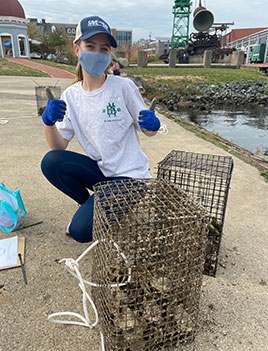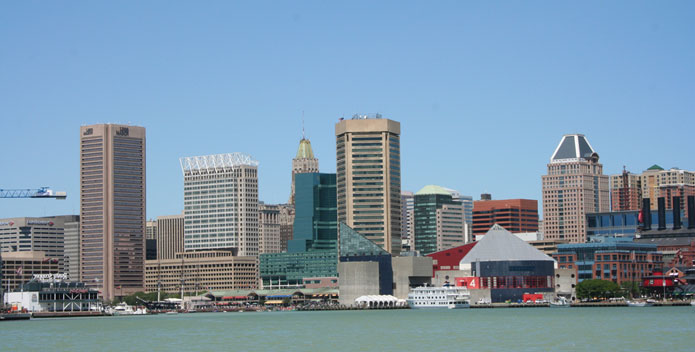Growing up in Baltimore’s Federal Hill, my life has been full of waterfront memories—passing runners on scenic morning jogs and watching the sunset from a bench at the park. However, I also have memories of sweltering summer afternoons where the lack of shade-providing trees (and the occasional smell of dead fish due to algal blooms) made the four-block walk to my best friend’s house almost unbearable.
Over time, I learned that experiences like mine are all too common and not evenly distributed. Volunteering in Sandtown-Winchester, a historically under-resourced part of Baltimore, I learned how systematic forms of discrimination have contributed to higher asthma rates in red-lined communities. To me, restoring the Chesapeake Bay means ensuring every resident of Baltimore has the right to clean water and healthy air, to explore and enjoy green spaces, and to thrive within their neighborhoods. Restoring the environment restores us.

CBF Student Leader Kaitlyn Leitherer at an oyster gardening event in Baltimore, Maryland.
CBF Staff
A week before I began volunteering in Sandtown-Winchester, I had joined the Chesapeake Bay Foundation for its July Student Leadership Masterclass. When my teacher at Bryn-Mawr School first shared the information about the online course with us, I was hesitant, but I took the risk and signed up.
Every day, at least one activity led us outside to explore and experiment while also following social distancing guidelines. One afternoon, after learning about what makes a healthy stream, I was on my way to evaluate the health of the closest waterway near me: the Inner Harbor. With my clipboard, CBF print-outs, and a mask, I left my air-conditioned house and stepped into the hot, humid summer afternoon. Instead of going straight to the harbor, I made a detour, going deeper into the city, so that I could pick up my best friend. In the early afternoon, the sun beat down from straight above, at an angle that prevented even the tallest of row houses from providing shade and protection from the sun’s rays. Each block, with each occasional, scrawny and bare tree I passed, I wished it could have been of more use, with fuller branches and leaves, especially during these scorching summers when I just wanted to walk to a friend’s house. By the time I came back home after my two-mile quest around Federal Hill and to the Harbor, I was sunburnt and covered in sweat.
The next day of the Masterclass, we had to think of what was essential for a person to thrive within their local environment, which we’d later include in our own Watershed Outdoor Bill of Rights. At first, I blanked, but then my sunburn, still stinging from yesterday’s walk, reminded me of at least one thing that was important to my urban community: trees. How could Baltimoreans stay happy, healthy, and active when the lack of trees intensifies the already significant urban heat-island effect?
As we created our Watershed Outdoor Bill of Rights, I not only gained a new understanding of essential outdoor rights, like the right to clean water and air, but I also gained the readiness to go out and protect these rights. In the months between CBF’s July Masterclass and our fall student leadership meetings, I pushed myself to be a more active watershed citizen, by advocating for issues I cared about to my local government. I’ve learned that when citizens are able to voice their opinions and be heard, big changes happen.
One of the most recent successes I’ve seen is through the ACE act, which was passed by Congress earlier this month. Legislation like the ACE Act stands by the rights we highlight in the Watershed Outdoor Bill of Rights and ensures clean water for all through the increased funding for the Chesapeake Bay Program, reauthorization of the Chesapeake Gateways and Watertrails Network, and the establishment of the Chesapeake WILD program. We need programs like these and the voices of watershed citizens to save the Bay. We’re all in this together.
Kaitlyn Leitherer, CBF Student Leader



